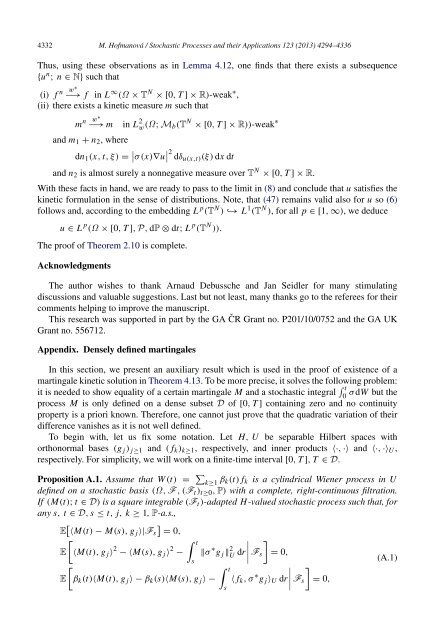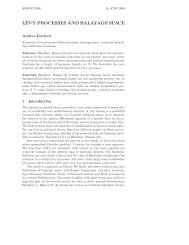Degenerate parabolic stochastic partial differential equations
Degenerate parabolic stochastic partial differential equations
Degenerate parabolic stochastic partial differential equations
Create successful ePaper yourself
Turn your PDF publications into a flip-book with our unique Google optimized e-Paper software.
4332 M. Hofmanová / Stochastic Processes and their Applications 123 (2013) 4294–4336<br />
Thus, using these observations as in Lemma 4.12, one finds that there exists a subsequence<br />
{u n ; n ∈ N} such that<br />
w∗<br />
(i) f n −→ f in L ∞ (Ω × T N × [0, T ] × R)-weak ∗ ,<br />
(ii) there exists a kinetic measure m such that<br />
m n<br />
w∗<br />
−→ m<br />
and m 1 + n 2 , where<br />
in L 2 w (Ω; M b(T N × [0, T ] × R))-weak ∗<br />
dn 1 (x, t, ξ) = σ (x)∇u<br />
<br />
2 dδu(x,t) (ξ) dx dt<br />
and n 2 is almost surely a nonnegative measure over T N × [0, T ] × R.<br />
With these facts in hand, we are ready to pass to the limit in (8) and conclude that u satisfies the<br />
kinetic formulation in the sense of distributions. Note, that (47) remains valid also for u so (6)<br />
follows and, according to the embedding L p (T N ) ↩→ L 1 (T N ), for all p ∈ [1, ∞), we deduce<br />
u ∈ L p (Ω × [0, T ], P, dP ⊗ dt; L p (T N )).<br />
The proof of Theorem 2.10 is complete.<br />
Acknowledgments<br />
The author wishes to thank Arnaud Debussche and Jan Seidler for many stimulating<br />
discussions and valuable suggestions. Last but not least, many thanks go to the referees for their<br />
comments helping to improve the manuscript.<br />
This research was supported in part by the GA ČR Grant no. P201/10/0752 and the GA UK<br />
Grant no. 556712.<br />
Appendix. Densely defined martingales<br />
In this section, we present an auxiliary result which is used in the proof of existence of a<br />
martingale kinetic solution in Theorem 4.13. To be more precise, it solves the following problem:<br />
it is needed to show equality of a certain martingale M and a <strong>stochastic</strong> integral t<br />
0<br />
σ dW but the<br />
process M is only defined on a dense subset D of [0, T ] containing zero and no continuity<br />
property is a priori known. Therefore, one cannot just prove that the quadratic variation of their<br />
difference vanishes as it is not well defined.<br />
To begin with, let us fix some notation. Let H, U be separable Hilbert spaces with<br />
orthonormal bases (g j ) j≥1 and ( f k ) k≥1 , respectively, and inner products ⟨·, ·⟩ and ⟨·, ·⟩ U ,<br />
respectively. For simplicity, we will work on a finite-time interval [0, T ], T ∈ D.<br />
Proposition A.1. Assume that W (t) = k≥1 β k(t) f k is a cylindrical Wiener process in U<br />
defined on a <strong>stochastic</strong> basis (Ω, F , (F t ) t≥0 , P) with a complete, right-continuous filtration.<br />
If (M(t); t ∈ D) is a square integrable (F t )-adapted H-valued <strong>stochastic</strong> process such that, for<br />
any s, t ∈ D, s ≤ t, j, k ≥ 1, P-a.s.,<br />
E <br />
⟨M(t) − M(s), g j ⟩|F s = 0,<br />
<br />
t<br />
<br />
E ⟨M(t), g j ⟩ 2 − ⟨M(s), g j ⟩ 2 − ∥σ ∗ g j ∥U 2 dr F s = 0,<br />
s<br />
<br />
t<br />
<br />
E β k (t)⟨M(t), g j ⟩ − β k (s)⟨M(s), g j ⟩ − ⟨ f k , σ ∗ g j ⟩ U dr<br />
F s = 0,<br />
s<br />
(A.1)



